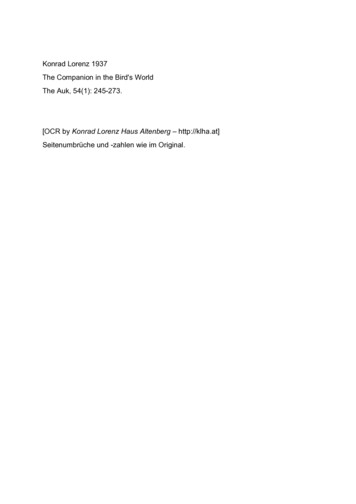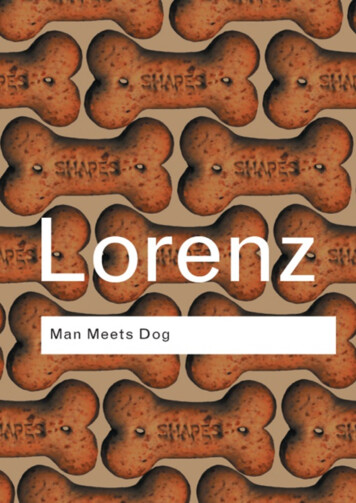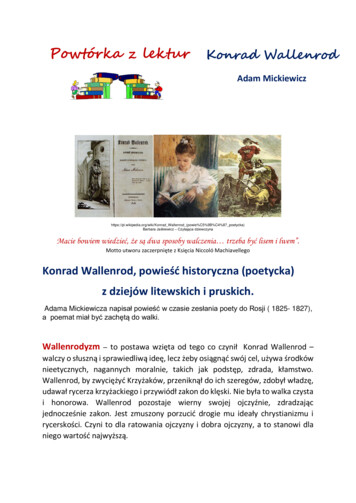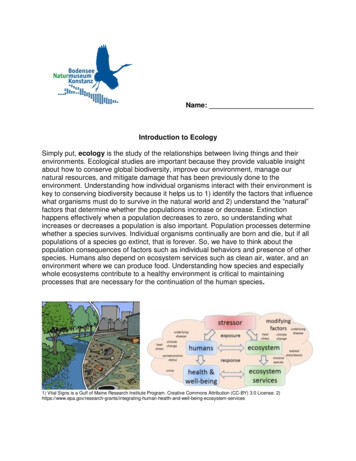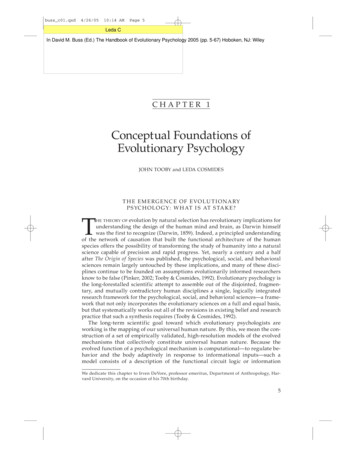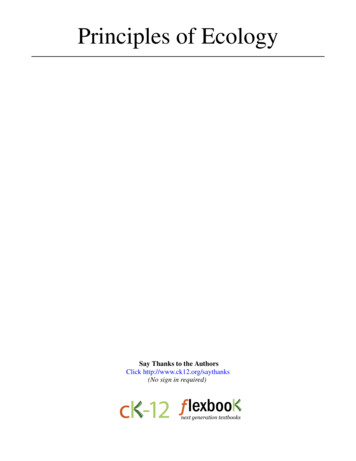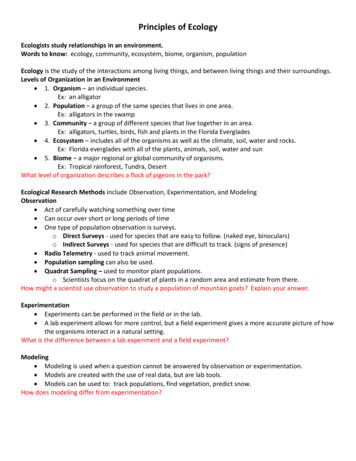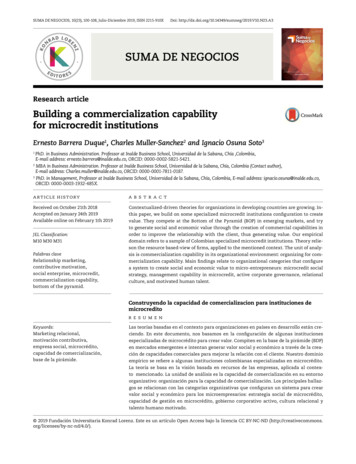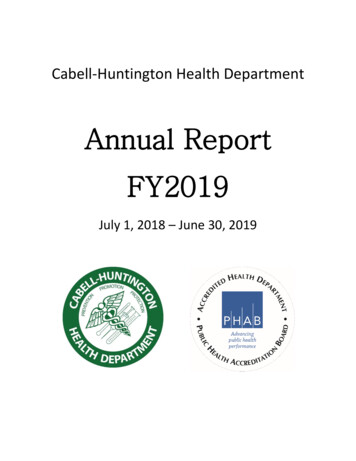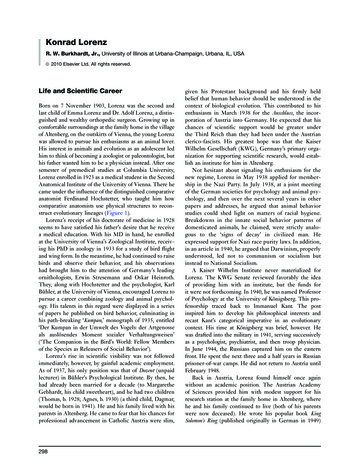
Transcription
Konrad LorenzR. W. Burkhardt, Jr., University of Illinois at Urbana-Champaign, Urbana, IL, USAã 2010 Elsevier Ltd. All rights reserved.Life and Scientific CareerBorn on 7 November 1903, Lorenz was the second andlast child of Emma Lorenz and Dr. Adolf Lorenz, a distinguished and wealthy orthopedic surgeon. Growing up incomfortable surroundings at the family home in the villageof Altenberg, on the outskirts of Vienna, the young Lorenzwas allowed to pursue his enthusiasms as an animal lover.His interest in animals and evolution as an adolescent ledhim to think of becoming a zoologist or paleontologist, buthis father wanted him to be a physician instead. After onesemester of premedical studies at Columbia University,Lorenz enrolled in 1923 as a medical student in the SecondAnatomical Institute of the University of Vienna. There hecame under the influence of the distinguished comparativeanatomist Ferdinand Hochstetter, who taught him howcomparative anatomists use physical structures to reconstruct evolutionary lineages (Figure 1).Lorenz’s receipt of his doctorate of medicine in 1928seems to have satisfied his father’s desire that he receivea medical education. With his MD in hand, he enrolledat the University of Vienna’s Zoological Institute, receiving his PhD in zoology in 1933 for a study of bird flightand wing form. In the meantime, he had continued to raisebirds and observe their behavior, and his observationshad brought him to the attention of Germany’s leadingornithologists, Erwin Stresemann and Oskar Heinroth.They, along with Hochstetter and the psychologist, KarlBühler, at the University of Vienna, encouraged Lorenz topursue a career combining zoology and animal psychology. His talents in this regard were displayed in a seriesof papers he published on bird behavior, culminating inhis path-breaking ‘Kumpan,’ monograph of 1935, entitled‘Der Kumpan in der Umwelt des Vogels: der Artgenosseals auslösendes Moment sozialer Verhaltungsweisen’(‘The Companion in the Bird’s World: Fellow Membersof the Species as Releasers of Social Behavior’).Lorenz’s rise in scientific visibility was not followedimmediately, however, by gainful academic employment.As of 1937, his only position was that of Dozent (unpaidlecturer) in Bühler’s Psychological Institute. By then, hehad already been married for a decade (to MargaretheGebhardt, his child sweetheart), and he had two children(Thomas, b. 1928; Agnes, b. 1930) (a third child, Dagmar,would be born in 1941). He and his family lived with hisparents in Altenberg. He came to fear that his chances forprofessional advancement in Catholic Austria were slim,298given his Protestant background and his firmly heldbelief that human behavior should be understood in thecontext of biological evolution. This contributed to hisenthusiasm in March 1938 for the Anschluss, the incorporation of Austria into Germany. He expected that hischances of scientific support would be greater underthe Third Reich than they had been under the Austrianclerico-fascists. His greatest hope was that the KaiserWilhelm Gesellschaft (KWG), Germany’s primary organization for supporting scientific research, would establish an institute for him in Altenberg.Not hesitant about signaling his enthusiasm for thenew regime, Lorenz in May 1938 applied for membership in the Nazi Party. In July 1938, at a joint meetingof the German societies for psychology and animal psychology, and then over the next several years in otherpapers and addresses, he argued that animal behaviorstudies could shed light on matters of racial hygiene.Breakdowns in the innate social behavior patterns ofdomesticated animals, he claimed, were strictly analogous to the ‘signs of decay’ in civilized man. Heexpressed support for Nazi race purity laws. In addition,in an article in 1940, he argued that Darwinism, properlyunderstood, led not to communism or socialism butinstead to National Socialism.A Kaiser Wilhelm Institute never materialized forLorenz. The KWG Senate reviewed favorably the ideaof providing him with an institute, but the funds forit were not forthcoming. In 1940, he was named Professorof Psychology at the University of Königsberg. This professorship traced back to Immanuel Kant. The postinspired him to develop his philosophical interests andrecast Kant’s categorical imperative in an evolutionarycontext. His time at Königsberg was brief, however. Hewas drafted into the military in 1941, serving successivelyas a psychologist, psychiatrist, and then troop physician.In June 1944, the Russians captured him on the easternfront. He spent the next three and a half years in Russianprisoner-of-war camps. He did not return to Austria untilFebruary 1948.Back in Austria, Lorenz found himself once againwithout an academic position. The Austrian Academyof Sciences provided him with modest support for hisresearch station at the family home in Altenberg, wherehe and his family continued to live (both of his parentswere now deceased). He wrote his popular book KingSolomon’s Ring (published originally in German in 1949)
Konrad LorenzFigure 1 Konrad Lorenz lecturing student research assistantsabout the principles of ethology during observations ofhand-raised geese at the Max-Planck-Institut fürVerhaltensphysiologie in Seewiesen in 1971. Photo by JanePackard.as a means of making money. In 1950, he appeared to bethe top choice to replace Karl von Frisch for the professorship of zoology at the University of Graz (Frisch wasreturning to his earlier post at Munich), but political andideological considerations scuttled his candidacy. Thiswould not be the last time that allegations of earlierNazi sympathies on his part caused him difficulties. Concluding that he had no chance of ever getting a professorial appointment in Austria, he appealed to colleaguesin Britain to find a position for him there. As they wentabout this task, Lorenz’s friend, the German behavioralphysiologist, Erich von Holst, persuaded the Max PlanckGesellschaft (MPG) (the KWG’s successor) to work tokeep Lorenz in Germany. The MPG quickly set up aninstitute for Lorenz in Buldern, Westphalia, under theauspices of Holst’s Max Planck Institute for Marine Biology in Wilhelmshaven. Lorenz gladly took up the newpost. In 1956, the MPG established for him and Holst anew Max Planck Institute for Behavioral Physiology inSeewiesen, near Starnberg, in Bavaria. Lorenz remainedthere until his retirement in 1973. He then returned hometo Austria and Altenberg, where he continued hisresearches. In the course of his long career, he receivedmany honors, including the 1973 Nobel Prize. He died on27 February 1989.Lifelong Scientific PracticesLorenz prided himself on being an animal lover. Thescientific value of being an animal lover, he liked toexplain, was that without the love of an animal, onewould never have the patience to watch it long enough299to become familiar with its entire set of behaviors.His own favored method of research was to raise wildbirds in a state of semicaptivity and observe them overthe course of months and even years, thereby allowinghimself to come to know the whole of a bird’s normalbehavior patterns. This also permitted him to witnessrare but instructive behavioral events that a field observermight never see, as for example when an instinct ‘misfired’in a situation where the proper stimuli for releasing itwere not present. In addition, by raising different speciesside by side, he was able to make comparative observations that again would not have been possible for a fieldobserver. On the other hand, he never developed the keenecological sense of a field biologist. Nor did he developstrong skills as an experimenter. He credited himself withan intuitive understanding of animals, on the basis of hisyears of close observation of how animals behaved.Given his predilection for raising animals, it is notsurprising that Lorenz developed a special admirationfor two of his predecessors in particular, the Americanbiologist Charles Otis Whitman (1842–1910) and theGerman ornithologist Oskar Heinroth (1871–1945), bothof whom raised birds and observed their behavior closely.Lorenz portrayed these two scientists, with some exaggeration, as animal lovers who were content to watch theirpigeons and ducks in a completely unbiased way, unburdened by any hypotheses. However, he also appreciatedtheir ideas. He credited Whitman with having discovered what he called the ‘Archimedean point’ on whichthe new science of ethology revolved. This was theidea that, as Whitman expressed it in 1898, ‘Instinctand structure are to be studied from the common standpoint of phyletic descent.’ Heinroth became a model forLorenz for his studies of how instincts function in aviansocial life.Lorenz’s first scientific publication (in 1927) was anempirical study reporting his observations on the behaviorof a tame, pet jackdaw. His experiences with this bird ledhim to want to understand how its instinctive behaviorsfunctioned in the life of a jackdaw colony. To this end, heestablished a colony of jackdaws in the attic of the familyhome, marked the birds for identification, and began studying the social life of jackdaws. His successes in this regardled him to study night herons and then graylag geese (alongwith a host of other species). He promoted his practices asthe key to advancing animal psychology. In his Kumpanpaper of 1935, he wrote that the proper method for theanimal psychologist in studying any species was to beginwith ‘an extensive period of general observation’ prior toany experimentation, and furthermore to focus on instinctsbefore tackling learning. The investigator unwilling tobegin by gaining a thorough familiarity of the full behavioral repertoire of his subject species, Lorenz admonished,‘should leave animal psychology well alone.’
300Konrad LorenzThe Conceptual Foundations of EthologyLorenz’s publications became increasingly theoretical inthe 1930s, as he addressed the nature of instincts and therole they play in the social life of birds. In a 1932 paper oninstinct, he argued that instincts and learning are whollydistinct from each other, even when they are ‘intercalated’in complex, coordinated chains of behavior. In 1935, in hisremarkable ‘Kumpan’ monograph, he advanced his theorizing further by employing the concept of the ‘releaser’ (anidea previously enunciated by the theoretical biologistJakob von Uexküll, with whom Lorenz had been interacting and to whom Lorenz dedicated the monograph). ByLorenz’s account, lower animals such as birds are adaptedto their environments not very much through acquiredknowledge (as are humans) but instead through highlydifferentiated instinctive motor patterns, created overtime by natural selection. To function effectively, theyneed to be released only by a very few stimuli emanatingfrom the thing to which the animal is responding. Thesestimuli, however, must characterize the object sufficientlywell that the animal does not respond to similar stimulicoming from an inappropriate object. Like a key fitting alock, the proper combination of stimuli evokes a responsefrom an ‘innate schema’ (later to be called the innatereleasing mechanism or IRM), releasing the performanceof its associated instinctive motor pattern.The interrelations of stimuli and innate schema,Lorenz proceeded to explain, were subject to even greaterrefinement when the sender of the stimuli and theirrecipient were members of the same species. Then thereleasing stimuli and innate schema could be mutuallyfine tuned over time by natural selection so as to make thefit between them ever more precise, resulting in combinations of such overall improbability that an animal’sinstinctive reactions would only rarely be triggered bystimuli from the ‘wrong’ object. Lorenz used the word‘releasers’ (Auslöser) for characters that serve to activatethe innate schemata of conspecifics. Releasers could bemorphological structures or conspicuous behavior patterns or, most often, a combination of both.Lorenz went on to describe how the highly organizedsocial life of jackdaws depends on a surprisingly small number of instinctive reactions to releasers provided by fellowjackdaws. Borrowing the idea of the ‘companion’ fromUexküll, who had used the word in the first place to describewhat Lorenz had told him about the social life of jackdaws,Lorenz maintained that every jackdaw has a number of socialdrives with respect to which other jackdaws serve as ‘companions.’ As ‘parental,’ ‘infant,’ ‘sexual,’ ‘social,’ or ‘sibling’companions they provide stimuli that release the innatebehavior patterns appropriate to the jackdaw’s drives.Lorenz’s Kumpan paper was also the site in which hecalled attention to the phenomenon he called ‘imprinting’(Prägung). Whitman and Heinroth, among others, hadbeen familiar with the phenomenon, but Lorenz was thefirst to focus scientific attention upon it. He reported thatin most bird species, the newly hatched baby bird doesnot have an innate ability to recognize its own kind; rather,the object of its instinctive behavior patterns is imprintedupon it in a brief, early period in its life. Thus, if a babygosling sees a human before it sees a mother goose, thegosling will follow the human, directing toward this fosterparent the instinctive behavior patterns that would undernormal circumstances have been directed toward membersof its own species. Lorenz distinguished imprinting fromlearning, likening it instead to embryological induction. Hemaintained that imprinting was irreversible.Lorenz’s Kumpan monograph evoked a strong, appreciative response among behaviorally oriented ornithologists, including Julian Huxley and Henry Eliot Howard inBritain and Margaret Morse Nice and Wallace Craig inthe United States. Lorenz had not yet, however, arrived athis final explanation of how instincts work physiologically.Up to this time, he had endorsed a chain-reflex theory ofinstinct. Between 1935 and 1937, he decided that thattheory was wrong. His interactions with the AmericanWallace Craig and especially the German Erich von Holstled him to jettison it in favor of a theory involving theinternal build up of instinctive energies. Holst’s studies ofthe endogenous generation and central coordination of nervous impulses led Lorenz to conclude that instincts involvesome kind of energy (later called ‘action-specific-energy)that builds up in the organism until it is released or itoverflows. This new theory made sense of what Craig hadcalled ‘appetitive behavior,’ where the animal seems internally motivated to seek the stimuli that will elicit itsinstinctive motor patterns. It also served to explain twophenomena that were apparently related to each other:‘threshold lowering’ and ‘vacuum activities.’ Thresholdlowering described the finding that the longer it had beensince an instinctive action was last performed, the easier itbecame for the behavior to be released. A ‘vacuum activity’was when an instinctive behavior pattern was performed‘in vacuo,’ that is, it ‘went off ’ without any apparent orappropriate releasing stimulus and thus without servingits proper biological function. These findings made nosense if one viewed instincts as chains of reflexes setin motion by external stimuli. They did make sense,Lorenz decided, if instincts were understood to be internally generated.While Craig and Holst were of special help to Lorenzin his theory building, the arrival of Niko Tinbergen onthe scene provided Lorenz with an ally who gave Lorenz’skey concepts critical experimental support. The two menfirst met at a conference on instinct held in Leiden inNovember 1936. In the presence of older animal psychologists who seemed primarily interested in gaining insightsinto the animal mind, Lorenz and Tinbergen found themselves sharing a different commitment. They both wanted
Konrad Lorenzto put animal behavior studies on a much firmer, objectivistic, physiological foundation. Tinbergen was impressedby Lorenz’s insights and ambition as a theorist. Lorenz wasecstatic to learn of the experiments that Tinbergen andTinbergen’s students at Leiden had been doing on theinstinctive behavior of the three-spined stickleback. Theiranalysis of the stimuli eliciting the sticklebacks’ instinctivemovements struck Lorenz as precisely what he needed.The following spring Tinbergen was given a leave ofabsence from his department at Leiden to go to Austria tostudy with Lorenz in Altenberg. There the two menworked together for three and a half months, conducting,among other projects, their classic study of the egg-rollingbehavior of the graylag goose. And there too they established a firm friendship. This friendship, which survivedthe strains of war and lasted for the rest of their lives, was ofmajor importance for the development of ethology as ascientific discipline.Lorenz’s publications during the war varied considerably in nature. They included his writings about domestication and racial degeneration and his paper arguing thatevolutionary biology was consistent with National Socialism; an early paper on evolutionary epistemology; anextended comparison of the instinctive behavior patternsof different duck species as a means of assessing theirgenetic affinities; and a major monograph on ‘the inbornforms of possible experience.’ He offered his duck study asa confirmation of the idea that the comparative methodcould be applied successfully to instincts in reconstructing phylogenies. His ‘inborn forms’ monograph was asweeping synthesis of his recent thinking in which headdressed such topics as instinctive behavior, domestication phenomena and the threat these posed to racialhygiene, the reinterpretation of Kantian epistemology inevolutionary terms, and what man might make of himselfin the future.Lorenz in the Postwar PeriodThe rebuilding of ethology immediately after the war fellto Tinbergen rather than Lorenz, since Lorenz did notreturn from the war until 1948. Lorenz’s first major occasion to present his ideas again after the war occurred at aspecial conference on physiological mechanisms in behavior, held in Cambridge, England, in 1949. There he offered avisual representation of the instinct theory he had developed. His ‘hydro-mechanical’ or ‘psycho-hydraulic’ model,as he called it, featured a reservoir containing a fluid, aspring valve connected by way of a pulley to a scale, and aweight on a scale (Figure 2). In this model, the fluidbuilding up in the reservoir represents action-specificenergy; the spring, pulley, and scale represent the innatereleasing mechanism; the weight on the scale represents thestimuli serving to trigger the innate releasing mechanism;301TRGVS123456Tr.1 kg.Sp.Figure 2 Konrad Lorenz’s psycho-hydraulic model ofinstinctive action. Reproduced from Lorenz KZ (1950)The comparative method in studying innate behaviour patterns.Symposia of the Society for Experimental Biology 4: 221–268.and the instinctive reaction itself is represented by the jet ofliquid coming through the valve, producing different resultsaccording to its strength. Although Lorenz acknowledgedthe ‘extreme crudeness and simplicity’ of this model, heinsisted that the model represented ‘a surprising wealth offacts really encountered in the reactions of animals.’ Themodel stimulated considerable debate and experimentationover the next decade. Although it came to be generallydiscredited by the end of the 1950s, Lorenz remainedattached to it, and he presented a revised version of it twodecades later.There is no doubt that Lorenz did his most creativework before and during the war, not after it. In 1950, priorto being given his first Max Planck institute, he complained to the British ethologist W. H. Thorpe that hewas not gaining any new knowledge but rather simplyusing up his capital of old knowledge. But this picture didnot change all that much even after he had special institutional resources at his disposal. His postwar intellectualactivity consisted primarily of recycling, developing, anddefending ideas he had formulated earlier. He did this,however, with great gusto, and he continued to be apowerful, charismatic leader of the field. He attractedstudents to study with him, he energized ethology’s international congresses, he challenged psychologists to putbehavior in an evolutionary perspective, and he providedthe public with an attractive view of the science of
302Konrad Lorenzethology, frequently highlighted by his own charmingimage as the foster mother of some imprinted ducklingsor goslings.As ethology began to flourish in the early 1950s, several of Lorenz’s key concepts drew criticism, both frominside the discipline and from other quarters. Amongethology’s own new recruits, Robert Hinde in particular called into question behavioral models involvingfluids flowing. Meanwhile, from outside the discipline,the American comparative psychologist Daniel Lehrmanlaunched a multipronged attack on Lorenzian ethology.Lehrman insisted, among other things, that Lorenz’s sharpdistinction between innate and learned behavior stood inthe way of a better understanding of how behavior develops in the individual. Much to Lorenz’s disappointment,some of his colleagues, including Tinbergen, came to feelthat Lehrman had a point. Lorenz himself, however, wasnot inclined to make concessions. Although his counterattacks on American behaviorists were not all that successful in addressing Lehrman’s actual complaints, Lorenzdid in the course of these debates introduce an instructiveconcept, which he playfully designated ‘the innate schoolmarm.’ This, as he expressed it in 1965, is the idea that anorganism’s ability to learn particular things is itself afunction of mechanisms that natural selection has builtinto that organism. In brief, innate mechanisms determinewhat a species can learn.Although always considering himself a good Darwinian and always insisting on the importance of bringingevolutionary perspectives to bear on animal behavior,Lorenz was better at applying the methods of comparativeanatomy to behavior than he was at thinking about themechanisms by which evolution operates. His remarks inthe latter regard simply reflected his confidence thatnatural selection typically works for ‘the good of thespecies,’ a view that came to be regarded as old-fashionedin the 1960s and 1970s as evolutionary biologists, behavioral ecologists, and sociobiologists promoted ideas ofindividual selection or kin selection instead of groupselection. In contrast, Lorenz’s efforts to understandhuman cognitive processes in evolutionary terms havebeen viewed as much more farseeing in nature, and he isregarded as a pioneer in evolutionary epistemology. Hisbook Behind the Mirror (published first in German in 1973)represents his mature thinking on the philosophical ideashe began developing in the 1940s, when he found himselfin his professorial chair descending from Kant.Lorenz from early in his career was eager to explorethe broader human implications of his studies of behavior.He enjoyed playing the role of the scientist-prophetbringing the lessons of biology to a society in peril. Thismotif appeared in his prewar and wartime warnings aboutgenetic deterioration in civilized man. It reappeared inhis first popular book, King Solomon’s Ring. Though thatbook is best known for Lorenz’s charming accounts ofhis experiences and observations as an animal-raiser,Lorenz concluded the book with a somber claim. Thehuman species, he maintained, is unique among higheranimals in that it lacks innate inhibitions against killing itsown kind. He returned to the theme of human nature inhis bestseller, On Aggression. There he portrayed aggression as an instinct that builds up naturally in humans as inanimals and ultimately needs release. The problem ofcivilized man, Lorenz argued, is that he does not havesufficient outlets for his aggressive drive. In the 1970s,in his slender volume entitled Civilized Man’s Eight DeadlySins, Lorenz became ever more pontifical, reciting awhole litany of dangers threatening humankind, includingoverpopulation, environmental destruction, genetic deterioration, and nuclear warfare.Lorenz’s LegacyAs early as the 1930s, Lorenz planned to write a generaltextbook on the study of animal behavior. He did notsucceed in doing so until 1978, when he published hisVergleichende Verhaltensforschung: Grundlagen der Ethologie(the English translation appeared 3 years later as TheFoundations of Ethology). By then, he was not trying towrite an up-to-date textbook on ethology. His emphasisinstead was on the founding concepts of ethology, whichhe felt modern ethologists were forgetting, to their detriment. In the book’s preface, and with some bitterness, helikened the recent development of ethology to the waythat the tips of a coral reef grow quickly away from itsfoundations, sometimes breaking off from where theystarted, and then dying or failing to develop in any cleardirection. Most of the reviewers of the book found itdisappointing. They saw Lorenz as clinging to conceptsthat had outlived their usefulness. Lorenz’s text included,among other things, a revised version of his old psychohydraulic model of instinctive action.Although many of Lorenz’s specific concepts did notremain central to the field, his historical significancefor the field’s development should not be understated.When Lorenz began his researches, zoologists showedonly marginal interest in behavior, European animal psychologists tended to endorse quasi-vitalistic or subjectivistic approaches to behavior, and American comparativepsychologists had little appreciation of interspecific differences in behavior or the value of looking at behaviorfrom an evolutionary perspective. Lorenz was the keyfigure in transforming this landscape. He demanded thatthe student of behavior gain, through assiduous anddetailed observation, a knowledge of the whole range ofbehaviors of multiple species, and that biological questions – questions in particular of evolutionary history,survival value, and physiology – be brought to bearon this material. He provided ethology with its early
Konrad Lorenzconceptual foundations; he attracted talented researchersto his cause; and he served as a highly visible and popularpromoter of the ideas and practices of his field. Althoughhis model of human aggression was disputed, his insistence that human behavior be considered in its broader,evolutionary context remains of fundamental importance.See also: Behavioral Ecology and Sociobiology; Comparative Animal Behavior – 1920–1973; Ethology inEurope; Future of Animal Behavior: Predicting Trends;Integration of Proximate and Ultimate Causes; Neurobiology, Endocrinology and Behavior.Further ReadingBurkhardt RW (2005) Patterns of Behavior: Konrad Lorenz, NikoTinbergen, and the Founding of Ethology. Chicago: University ofChicago Press.Lehrman DS (1953) A critique of Konrad Lorenz’s theory of instinctivebehavior. The Quarterly Review of Biology 298: 337–363.Lorenz KZ (1935) Der Kumpan in der Umwelt des Vogels: derArtgenosse als auslösendes Moment sozialer Verhaltungsweisen.Journal für Ornithologie 83: 37–215; 289–413.303Lorenz KZ (1941) Vergleichende Bewegungsstudien an Anatiden.Journal für Ornithologie 89. Ergänzungsband 3: 194–293.Lorenz KZ (1943) Die angeborenen Formen möglicher Erfahrung.Zeitschrift für Tierpsychologie 5: 235–409.Lorenz KZ (1950) The comparative method in studying innate behaviourpatterns. Symposia of the Society for Experimental Biology 4:221–268.Lorenz KZ (1952) King Solomon’s Ring. London: Methuen.Lorenz KZ (1965) Evolution and Modification of Behavior. Chicago:University of Chicago Press.Lorenz KZ (1966) On Aggression. New York: Harcourt Brace and World.Lorenz KZ (1970–1971) In: Studies in Animal and Human Behaviour2 vols). Cambridge, MA: Harvard University Press.Lorenz KZ (1974) Civilized Man’s Eight Deadly Sins. New York andLondon: Harcourt Brace Jovanovich.Lorenz KZ (1977) Behind the Mirror: A Search for a Natural History ofHuman Knowledge. London: Methuen.Lorenz KZ (1981) The Foundations of Ethology. New York and Vienna:Springer-Verlag.Lorenz KZ and Tinbergen N (1938) Taxis und Instinkthandlung in derEirollbewegung der Graugans, I. Zeitschrift für Tierpsychologie 2:1–29.Taschwer K and Föger B (2003) Konrad Lorenz: Biographie. Paul ZolnayVerlag: Vienna.Whitman X (1898) Animal behavior. Biological Lectures fromthe Marine Biological Laboratory Wood’s Holl, Mass 1898:285–338.
Konrad Lorenz 299. The Conceptual Foundations of Ethology Lorenz's publications became increasingly theoretical in the 1930s, as he addressed the nature of instincts and the role theyplayin the social lifeof birds. In a 1932 paper on instinct, he argued that instincts and learning are wholly
